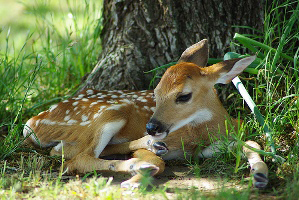White-tailed deer prepare for harsh, northern winters by fattening up in autumn (in many areas, they feed heavily on acorns). They tend to lose weight all through winter on a diet of woody browse.
Photo Credit: Becky McCray
Odocoileus virginianus
Common Name: white-tailed deer
Animal Guild: Mammal
Class > Order > Family: Mammalia > Artiodactyla > Cervidae
What does the species look like?
Their fur is tan or reddish-brown in summer, and grayish-brown in winter. Their ears are large and may move independently. Males have antlers. The upper side of the tail is brown with a white edge (often a darker stripe down the middle), while the underside is white. Juveniles have spotted fur.
Where is the species found?
States & Provinces
AB, AL, AR, AZ, BC, CO, CT, DC, DE, FL, GA, IA, ID, IL, IN, KS, KY, LA, MA, MB, MD, ME, MI, MN, MO, MS, MT, NB, NC, ND, NE, NH, NJ, NL, NM, NS, NT, NY, OH, OK, ON, OR, PA, PE, QC, RI, SC, SD, SK, TN, TX, UT, VA, VT, WA, WI, WV, WY, YT
Distribution
Their range extends from northwestern and southern Canada south through most of the United States, Mexico, and Central America to northern South America (Bolivia, northern Brazil, Colombia, French Guiana, Guyana, Peru, Surinam, and Venezuela). The species has been introduced in the Czech Republic, Finland, New Zealand, and the West Indies.
White-tailed deer occupy many types of habitats, including forests, forest edges, shrublands, grasslands with shrubs, and residential areas. They are often found near agricultural lands. In the north in winter, they tend to stay in areas with minimal snow cover, if possible. In dry regions, white-tailed deer prefer moist habitats along streams or in mountain forests.
Which phenophases should I observe?
Do you see/hear...?
Activity
Live individuals More...
For abundance, enter the number of individual animals observed in this phenophase.
Feeding For abundance, enter the number of individual animals observed in this phenophase.
Reproduction
Male combat For abundance, enter the number of individual animals observed in this phenophase.
Mating For abundance, enter the number of individual animals observed in this phenophase.
Development
Young individuals For abundance, enter the number of individual animals observed in this phenophase.
Dead individuals For abundance, enter the number of individual animals observed in this phenophase.
What do these phenophases look like?
There is currently no photoguide available for this species. If you'd like help us create one, use the guidance document and species template provided here . Then send it via email to education@usanpn.org when it is complete.
